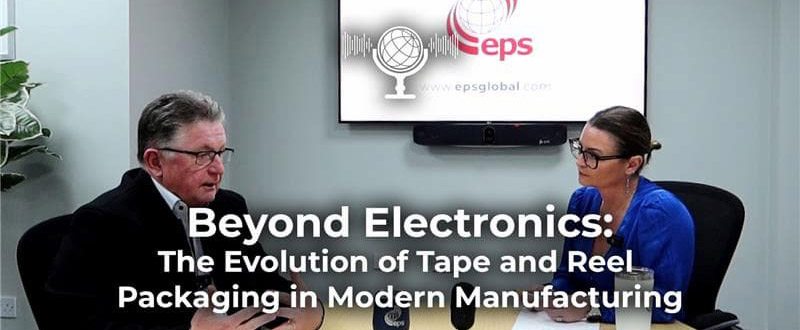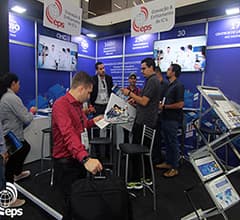Home > News & Blog > Component Packaging for the Assembly Line
Beyond Electronics: The Evolution of Tape and Reel Packaging in Modern Manufacturing

Manufacturing efficiency in today's competitive landscape demands innovative approaches to component handling and assembly automation. The evolution of tape and reel packaging technology has expanded beyond its traditional electronic component roots, offering sophisticated solutions for a wide range of industrial applications.
Through advanced engineering and custom design capabilities, these systems are fundamentally changing how manufacturers approach production line optimization and automation integration.
Transcript of The Evolution of Tape and Reel Packaging in Modern Manufacturing
Ciara: I'm here today with Mick McCarthy, our Chief of Operations looking after all of our programming services centres globally.
We're here today to talk about component packaging and how it can benefit the manufacturing industry with the recent opening of our services centre in Turvey in Dublin. Can you start by explaining what tape and reel packaging is, and its role in electronics manufacturing?
Mick: Tape and reel packaging evolved alongside surface mount technology (SMT) to enable efficient component placement on both sides of printed circuit boards. The process involves placing SMT components into carrier tape with precise orientation, sealing them, and winding the tape onto 13-inch reels.
This packaging method allows for much higher component density at the assembly line compared to tray packaging, enabling longer production runs and greater manufacturing efficiency. The system works particularly well for components like gull-wing and QFP packages that require production-ready presentation for automated placement.
Ciara: How has tape and reel packaging evolved to accommodate items outside of electronics?
Mick: The automation of component placement has expanded well beyond electronics manufacturing. Today, tape and reel packaging serves diverse industries including:
- Automotive: Clips and PCB retention components required in millions of units
- Thermal management: Small metal pieces for heat sink applications
- Medical technology: Sensors and specialized components
- Pharmaceutical: Precision components for medical devices
- General manufacturing: Any application requiring high-density, repeatable component placement
This expansion into non-electronic applications represents a significant business opportunity, as the demand for carrier tape packaging continues to grow across multiple sectors. The method's efficiency and precision make it increasingly valuable for any industry requiring automated placement of small components.
Ciara: You've mentioned heatsinks and you've mentioned sensors in the medical space, what kind of applications do they go into?
Mick: For example, recently a power tool manufacturer needed a solution for heat dissipation in their hand drill handles. The application required precisely manufactured heat sinks to be placed near the internal PCBs. By using tape and reel packaging, they could efficiently automate the placement of these metal components during assembly, ensuring consistent heat dissipation in the final product.
Ciara: For tape and reel packaging of heat sinks, how important is component orientation?
Mick: For metal components like heat sinks, orientation is generally flexible unless the component has distinct top and bottom surfaces. Most pieces are symmetrical (rectangular or square), so placement requirements are straightforward and can be customized to meet specific customer needs.
Ciara: What about sensors?
Mick: On the sensor side of things, for example in the medical space, glucose monitoring systems represent a key application where tape and reel packaging is valuable. These wearable devices contain sensors that transmit patient data via Bluetooth or Wi-Fi to central monitoring systems.
Mick: This is an important point I've emphasized for years. In a typical SMT facility with 10 production lines, you'll see automated chip shooters handling the main assembly, but then large crews manually attaching I/O connectors and bulkier components needed for board-to-board communication at the end of each line.
We've helped clients improve efficiency by converting these manual processes to tape and reel. This presents some technical challenges - primarily ensuring the SMT machines can reliably pick components from the tape. The solution often involves finding or creating a flat pickup surface on the connector. In some cases, we apply Kapton tape to the placement area, allowing the machine to pick and place the component before removing the tape.
The impact on workforce efficiency is substantial. In a three-shift operation, this automation can eliminate the need for 18-21 workers previously required for manual end-of-line assembly, simply by presenting components in a format compatible with automated placement.
Ciara: So automatic instead of manual labour there at the end of the line? That's very interesting.
Can you explain how custom tape and reel solutions are designed for unique components? Specifically, what are the dimensional capabilities and shape possibilities?
Mick: Yes. We have comprehensive capabilities for designing custom pocket geometries within our tape specifications. Our tape width ranges from 8mm (~5/16") to 88mm (~3 1/2″), with pocket depth being the main constraint. This depth is primarily limited by the reel size - for example, components requiring 18-20mm deep pockets will reduce the number of components that can be wound onto a 21-inch reel due to the increased circumference. Despite these practical limitations, we regularly produce 20mm deep pockets on 88mm tape for larger components.
Ciara: Thanks for that explanation. I have seen at Christmas time some candy that had been tape and reeled for handing out at various events so it applies to everything really!
What advice would you give to companies considering custom tape and reel solutions for their products?
1. Evaluate their current manufacturing process:
- Analyze their intended assembly method
- Identify opportunities for automation and digitization
- Review each manufacturing step for potential efficiency gains
2. Consult with our engineering team to:
- Assess the feasibility of tape and reel packaging
- Determine specific component requirements
- Evaluate potential efficiency improvements
3. Benefit from our comprehensive design process:
- EPS Global's in-house R&D team designs custom pockets
- We take into account special considerations for complex components (like keeping contacts isolated)
- We have 3D printing capabilities for prototype testing
- We conduct a physical fit verification before final production
Our end-to-end design process ensures that the final solution works precisely as intended, with all technical requirements met before implementation.
Glossary of Terms
- SMT (Surface Mount Technology) - A method for producing electronic circuits where components are mounted directly onto the surface of printed circuit boards.
- Through-hole Technology - A mounting scheme where component leads are inserted into holes drilled in the printed circuit board and soldered on the opposite side.
- Carrier Tape - A specialized tape with pockets designed to hold and transport components for automated assembly processes.
- QFP (Quad Flat Package) - A surface mount integrated circuit package with leads extending from all four sides.
- Line Side - The area alongside production/assembly lines where components are staged for use.
- PCB (Printed Circuit Board) - A board that mechanically supports and electrically connects electronic components.
- Chip Shooters - Automated machines that place electronic components onto circuit boards at high speeds.
- I/O (Input/Output) - Connectors and components that enable communication between a circuit board and external devices.
- Kapton Tape - A polyimide film used in electronics manufacturing for its heat resistance and reliability.










